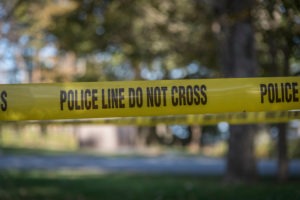Click on image to enlarge vie w.
Lack of smoke detectors. Although commonsense features such as smoke detectors in res ident rooms are effective in alerting staff to a fire while it is still relatively manageable, smoke detectors are not required in unsprinklered nursing homes.3 Cms has stated that it will pursue a regulatory ch ange requiring installation of smoke detectors in every resident room.3Only nursing homes su rveyed under federal standards for new construction since 1981 are required to have either corridor or in-room smoke detectors.3 According to fire inspectors, the lack of smoke detectors in resident rooms in the Hartford and Nashville facilities might have contributed to a delay in staff response and fire department noti fication.3 Compare this with the presence of smoke detectors in resident rooms in a December 2003 nu rsing home fire in Nevada where a resident smoking in bed while on oxygen started a fire at 2:20 a.m.3 Staff were alerted by the in-room smoke detector, and the fire was extinguished before it caused a significa nt amount of damage. While the resident who started the fire subsequently died as a result of the fire, no othe r deaths were reported. Although the facility was equipped with automatic sprinklers, the buildup of heat from the fire had not reached a level sufficient to activate the sprinklers. Lack of smoke dampers. Th e new standards require smoke dampers where ductwork passes through a smoke barrier, and older homes, such as t he Nashville facility, will no longer be grandfathered under earlier editions of the Life Safety Code th at do not include such a requirement.3 However, a facility that lacks dampers in ductwork as require d by current federal standards could still be certified for Medicare or Medicaid by obtaining a waiver for this requirement from CMS. However, CMS guidance still requires smoke detectors in resident rooms and fire-rated se paration of resident rooms as compensating features when considering waivers for some unsprinklered one-story, wood-frame facilities. Fire or smoke barriers in unsprinklered facilities. Another potential weak ness in federal standards, particularly in an unsprinklered facility, is that resident rooms are not required t o be separated from each other by fire or smoke barriers.3 History has shown that smoke is the cause of most fire deaths. Consequently, fire-resistant smoke barriers extending uninterrupted from floor slab to ro of slab passing through all concealed spaces become an important fire-protection feature. In the Hartford nursi ng home fire, residents in the room adjacent to the room of fire origin died from smoke inhalation. Smoke and f ire spread through the space above a false ceiling. The federal standard currently dictates installation of com plete fire and smoke barriers between corridor and resident rooms, not between resident rooms. Inadeq uate resident smoking policies. Nursing homes must recognize the resident’s right to smoke, adhere to feder al regulations governing smoking, and follow Life Safety Code provisions on the subject.1,2 W ritten facility policy and procedure might address, among other topics: - identification and hours for des ignated, well-ventilated smoking area(s);
- rules for resident smoking;
- procedures for identifying and documenting unsafe smoking behaviors (e.g., smokes in unauthorized areas, hoards matches, or hands shake) and incorporating the information into resident’s care plan;
- family notification of resident’s unsafe ac tivities;
- job description for smoking attendants (e.g., distributing cigarettes, providing lighting serv ices, monitoring disposal of burning ashes, applying and removing smoking aprons, and identifying dangerous or noncompliant behavior);
- rules for obtaining and keeping cigarettes, lighters, or matches; and
- r equirements for staff in-service education and training (e.g., training in use of fire blankets and extinguishe rs).11
Facilities should compare their smoking policy with actual resident smoking practices. In addition, they should examine policy and procedure concerning residents who smoke, particularly while physical ly restrained. The resident’s nursing home record should document the risk factors for burns associated with sm oking and the interventions undertaken by the facility to reduce or eliminate the identified hazards: for examp le, instructing the resident in safe smoking practices, allowing the resident to smoke only when supervised, re moving smoking materials from the resident who is unable to comply with facility policy, or requesting visitors not to give smoking materials to the resident. Unsupervised residents smoking. In Lawson v. S kyline Healthcare Center, for example, an unsupervised California nursing home resident with AIDS who was t aking medication that often made him fall asleep in his wheelchair suffered severe burn-related injuries after accidentally lighting the wrong end of a cigarette, causing a fire that spread to his body.12 He wou ld obtain cigarettes from a nurse’s station, and a staff member was supposed to supervise him while he smoked. Jurors found both parties negligent and apportioned fault at 70% percent to the nursing home and 30% for the re sident. The California Court of Appeal affirmed the jury verdict, disagreeing with the defendant nursing home’s arguments that under the doctrine of assumption of the risk, the resident was solely to blame for his injuries . Poor posture control, hand dexterity, or confusion increases the chances of burn-related injuries and deaths among nursing home residents who smoke. In Taylor v. Vencor, Incorporated, for instance, a reside nt who required direct supervision while smoking cigarettes because of mental and physical problems died from b urns after her nightgown caught fire.13 The wrongful death action alleged that the facility failed, through inadequate staffing of its designated smoking area and other negligent behavior, to adequately observe and supervise the resident while she smoked. The North Carolina Court of Appeals allowed the wrongful death sui t to advance, concluding that the claim constituted ordinary negligence rather than medical malpractice; thus, the court did not require review by a qualified expert witness willing to testify that the facility’s medical c are fell below the applicable standard of care because “preventing a resident from dropping a match or lighted cigarette upon themselves, while in a designated smoking room, does not involve matters of medical science.” Similarly, in Donson Nursing Facilities v. Dixon, for instance, the Georgia Court of Appeals held a nursing home liable for failing to supervise a mentally confused resident who, while smoking in bed, started a fire that killed him.14 The facility knew of the resident’s careless smoking habits and propensity to set fires while smoking and failed, despite this knowledge, to exercise any supervision of the decedent. Visitor providing residents with smoking materials. Family members, visitors, other residents, or fa cility staff may provide smoking materials to residents. Consider LeBlanc v. Midland National Insurance Comp any, where the Louisiana Court of Appeal affirmed a verdict in favor of the nursing home after a resident w as burned while smoking a pipe, reasoning that the facility at one time had removed all smoking materials, but the resident’s family demanded that the resident be allowed to smoke.15 In Black v. Trevilla Nurs ing Home of New Brighton, for example, the Minnesota Court of Appeals learned of an unattended, wheelchair- bound resident who allegedly died as a result of a burn sustained from “combustibles, smoking materials, matche s, or other incendiaries” negligently allowed by the facility.16 Purposeful or accidental igniting of physical restraints. The deliberate, purposeful, or accidental igniting of physical restraints also may result in death or injury.17,18 For example: A 76-year-old nursing home resident diagnos ed with dementia died two days after suffering third degree burns over 56% of his body when his clothing caught fire. Allegedly, the resident was found standing and ablaze from the waist up after facility staff responded t o screams. In a subsequent negligence lawsuit, the decedent’s surviving heir claimed that the resident had been placed in a vest restraint without a physician’s order in violation of federal and state regulatory rules and procedures. She also claimed that the facility administrator had instructed employees to restrain the resident when his family members left the premises after visiting. The plaintiff also alleged that the facility had an i neffective smoking policy despite knowledge that some residents had cigarettes and lighters. She theorized that the resident’s roommate, who also suffered from dementia, either lit a cigarette for the decedent or tried to help him use a cigarette lighter to burn off the restraining vest’s straps. The resident’s room was cleaned and painted at night immediately after the fire. A fire investigator allegedly found a trash bag in a Dumpster con taining the decedent’s clothing and the remains of the vest. The administrator denied the allegations. A Texas Department of Human Services investigation prompted the establishment of an involuntary trusteeship to operate the facility and return it to compliance with federal and state regulations. A $1,350,000 settlement ended the negligence suit.19 Conclusion
Residents, staff, and public safety personnel deserve the highest level of protection from the risks presented by fire. CMS must improve its oversi ght of nursing home fire safety by, among other possibilities, reviewing the appropriateness of exemptions to f ederal standards granted to unsprinklered facilities, strengthening fire safety standards to include mandatory sprinkler systems in all nursing homes, and thoroughly investigating any future multiple-death nursing home fir es to evaluate the adequacy of fire safety standards. |











